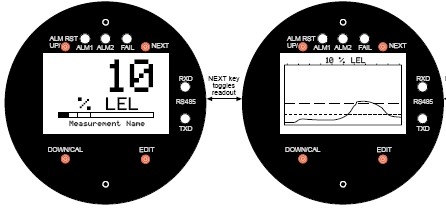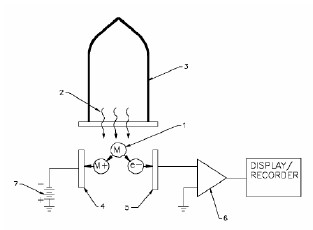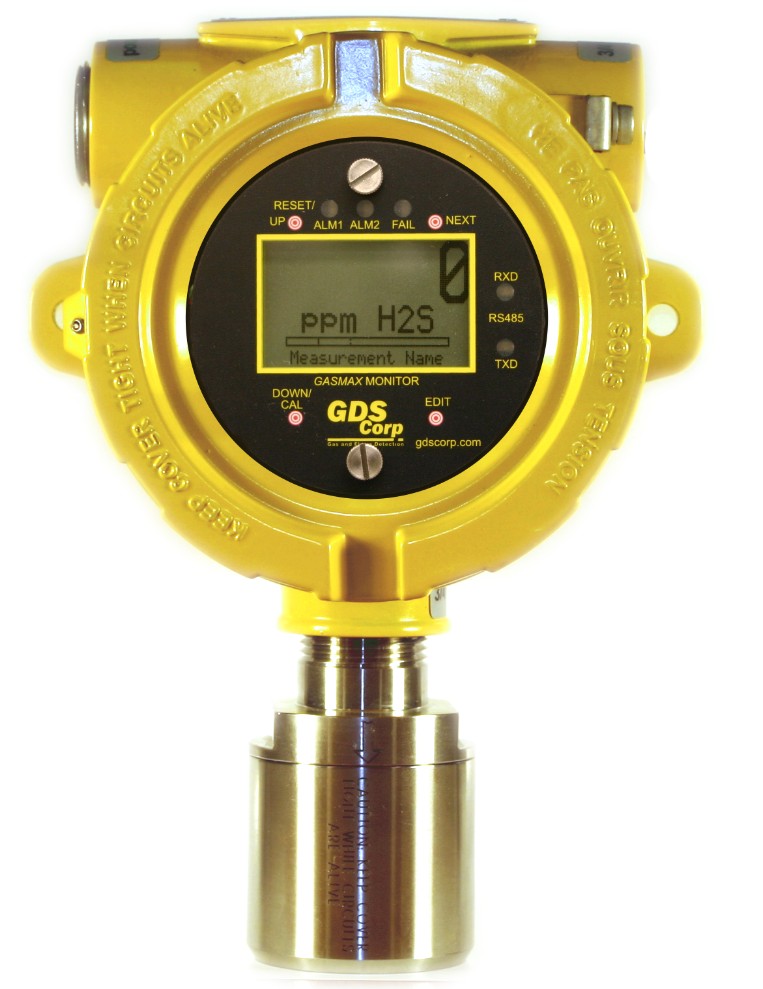The GASMAX II gas monitor for VOCs
uses a photoionization detector (PID) to
detect concentrations of volatile organic
compounds (VOC) such as benzene, toluene, xylene and chlorinated hydrocarbons.
PID Sensor Technology
The PID Smart Sensor is available in
High Range (0-300 ppm) and Low Range
(0-50 ppm) for maximum flexibility. The
PID sensor is fitted with replaceable 10.6
eV or 9.6 eV source lamps designed to
ionize the most commonly found VOCs
while remaining insensitive to changes
in humidity, oxygen or CO2 levels. Any
compound with an ionization potential
lower than the lamp value can be detected
with the GASMAX II / PID monitor.
Built-in dual channel electronics allow the
GASMAX II to support any GDS Corp
oxygen or toxic gas sensor in combination
with the photoionization detector.
Advanced User Interface
The highly visible backlit display and high
intensity alarm LEDs constantly show
alarm status, gas reading and programmable tag name; a second screen shows
alarm levels and the most recent 30
minute trend. An internal real-time clock
and event log time-stamp calibration and
alarm events for later review. A menudriven operator interface using magnetic
keys eliminates all analog potentiometers
and allows complete setup and calibration
without hazardous area declassification.
 Flexible Output Options
Flexible Output Options
In addition to standard dual 4-20mA
current loop outputs, an optional dual isolated 4-20mA output board or an RS-485
2-wire MODBUS® interface with three
5A SPDT relays are available to communicate with controllers or drive local
alarm indicators. When used with the C1
Protector Controller’s MODBUS master
port, multiple GASMAX II monitors can
be daisy-chained up to 500m.
Reliable
Available in both single and dual channel
models, the GASMAX II is CSA certified for use in Class I, Div 1 explosion
proof installations. For low temperature
applications, an Extended Temp option
adds thermostatically controlled heaters to
enable operation as low as –55°C ambient
for electrochemical sensors.
FEATURES
- CSA Certified for Class I, Div 1
explosion-proof installations
- Monitor both toxic gases and
VOCs with one detector
- Graphic display shows values,
units, trend graph, alarm levels
- Supports both local and remote
sensors for easy installation
- Non-intrusive, prompted calibration with programmable cal gas
- Power-up and post-calibration
delays eliminate false alarms
- Backlit display for better visibility
in low light conditions
- Options for 3x 5A alarm contacts,
isolated 4-20mA and MODBUS®
- Security settings to lock critical
parameters
- Auto-recognition of Smart Sensors
uploads calibration data & more
- Fault supervision circuitry detects
failed sensor & transmits warning
- Setup in hazardous area requires
only simple magnetic wand
- Optional 9.6 eV sensor suitable for
detection of Benzene
- Manufactured in USA
About VOC
PID (Photo Ionization Detection) technology detects a wide variety of organic and some inorganic gases in ambient air, generally low concentration of complex hydrocarbon molecules; this allows an early warning for presence of these gases in concentrations not seen by conventional LEL detectors.Below is a list of common gases and their ionization potentials, PID technology can be used when the IP value is less than 10.6 eV, the lower the better.
VOCs are organic compounds characterized by a tendency
to evaporate easily at room temperature with the potential
of forming a toxic gas concentration. While some
volatile organic compounds (VOCs) are acutely toxic at
low concentrations, the harmful eff ects of most VOCs
are delayed. Negative eff ects may occur long after the
primary exposure thus many people ignore the potential
danger. Long-term eff ects can include leukemia, memory
problems, loss of hand-eye coordination, cancer, and a
range of other physiological aff ects.
Many personnel
throughout the world are unprotected from VOCs in their
daily work either because they are unaware of the toxic
hazards, or because they are without a monitor that detects
for these gas concentrations.
Most VOCs have surprisingly low occupational exposure
limits. An increased awareness has resulted in several
newly revised VOC exposure limits, including TLVs for
diesel vapor, kerosene, and gasoline. Photoionization
detectors (PIDs) are able to detect VOCs and large
hydrocarbon molecules that are undetectable by catalytic
and electrochemical sensors.
Hexane provides a good example. The PEL for hexane in states that follow federal OSHA guidelines is an 8-hour time weighted average limit of 500 ppm. The NIOSH Recommended Exposure Limit (REL) followed by many states is an 8-hour TWA of only 50 ppm. The American Conference of Governmental Industrial Hygienists Threshold Limit Value (TLV) for hexane is also an 8-hour TWA of only 50 ppm. Many federal, state, and corporate health and safety standards require compliance with TLV exposure limits. The lower explosive limit concentration for hexane is 1.1%.
Below 1.1% volume hexane, the concentration of hexane vapor to air is too low to form an ignitable mixture. The most commonly cited hazardous condition thresholds for combustible gas are 5% LEL or 10% LEL. Thus, with a properly calibrated combustible gas reading instrument, assuming the alarm is set at 10% LEL, it would take a concentration of 10% of 1.1%, that is, 0.11% volume hexane, to trigger an alarm. Because 1% volume equals 10,000 ppm, every 1% LEL increment for hexane is equivalent to 110 ppm. It would therefore take a concentration of 1,100 ppm hexane to trigger an alarm set to the standard 10% LEL hazardous condition threshold. Even if instruments are set to alarm at 5% LEL, it still would still require a concentration of 550 ppm to trigger the alarm
The Photoionization Detector (PID) detects a wide variety of organic compounds and some inorganic gases
in ambient air. Whether or not a compound can be detected by a PID depends on the lamp energy and the
energy required to remove an electron from the target compound molecule (its ionization potential). If the
lamp energy is greater than the compounds ionization potential, the PID will detect it.
Due to its sensitivity, a PID is not recommended for high concentrations of target gases. However, a PID
does not require oxygen to operate and so would be the detector of choice in conditions where O2 levels are
unpredictable. A PID can also react to a number of inorganic substances, including Ammonia, Carbon
Disulfide, Carbon Tetrachloride, Chloroform, Ethylamine, Formaldehyde and Hydrogen Sulfide.
A typical PID block diagram is shown below. Molecules of interest (1) are being exposed to high-energy
ultra-violet radiation (2), generated by the gas discharge lamp (3). Some percentage of these molecules are
ionized, i.e. converted into positively charged ions and negatively charged electrons:
To be ionized, the molecule M should have its Ionization Potential (IP) smaller than the energy of UV lamp
photons (E). As a rule, the bigger the difference is between E and IP, the bigger the detector response.
Both E and IP are usually measured in electron-volts (eV). For the Ionization Potentials of various
chemicals, refer to the Documents tab.
The pair of electrodes (4, 5) is located in the ionization volume near the lamp window. One of them
(polarizing electrode, 4) is connected to the High Voltage DC source (7), the other (signal electrode, 5) is
attached to the amplifier (6) input. The electric field, created
by these two electrodes, forces both electrons and ions to drift
towards their respective electrode, by which they are being
collected. The resulting small current is being amplified by the
amplifier chip and then the output analog signal is recorded
and/or displayed in digital or analog format. The output signal
is proportional to the concentration of ionizable molecules in
detector chamber and thus serves as a measure of
concentration. Major air components (N2, O2, CO2) are not
ionized by typical lamp radiation and therefore do not
generate any detector response. For this reason, PID is very useful for detection of a wide range of VOCs
(Volatile Organic Compounds) in ambient air, down to the low-ppb concentrations, without interference from
air components.

 ) Reviews |
Write One
) Reviews |
Write One
